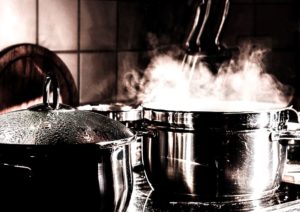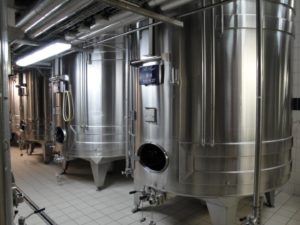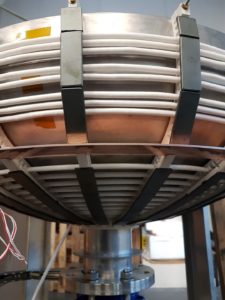Most people know induction heating via the induction hobs and cooking. In these applications, the most appreciated quality is their dynamic, displayed by their ability to go from high power, high temperature to low power, low temperature or the other way around. It is something like a five-octave vocal range singer. Unfortunately, these induction hobs have only been designed for the ferritic steels used for the cooking pan.
Many people would like to use induction to heat austenitic stainless steel. These kind of stainless steel (for exemple :304L; 316L…) have a much better reputation than the ferritic ones and have become standards in many industries. At this point, we must add that nowadays some ferritic steels have quite as good oxidation resistance than the 304L.
Moreover, to combine the great corrosion resistance and have less stress corrosion cracking than the 316L, Duplex stainless steels are a solution with magnetic properties in-between austenitic and ferritic stainless steels.
Austenitic stainless steel is not fitted for induction hobs, because it has low heating efficiency. For ferritic stainless steel, this efficiency is about 95% with an induction hob and can reach 98% with an industrial system using high quality litz wire. You may think that there is not much of a difference between 95% and 98%, but just think about the losses in the inductor coil (doubled from one case to the other) and therefore the ability of not being able to cool it. For austenitic steel this density decreases to 80% which means than 1/5 of the power is lost and just used to heat the coil. Useful to recycle the litz wire into melted copper! In some particular cases, with using a very well-designed Litz wire coil it is possible to reach an efficiency of 95%, which can be correlated this with a power density of about 7W/cm². If the power density is higher the system will be unable to evacuate the inductor losses and it will be destroyed. Of course, the other solution is to use a water-cooled tube inductor where power density will only be limited by the calefaction of the cooling liquid.
From a general point of view, Austenitic stainless steel can be heated by induction, only at low power density if using an air cooled litz wire inductor and at much higher power density if using a water-cooled inductor. But each case if different as physics has its pros and cons :
- Pros: If the thickness of the metal sheet is between 0.1 and 0.5 mm the behaviour of the austenitic stainless steel is as good as a ferritic stainless steel… Beware this also means that a great part of the magnetic field will flow through the metal sheet.
- Cons 1/3: According to the process of manufacturing, ferrite (α-iron) can appear in the welded area, which means that this area is magnetic and so will be heated much more than the non-welded areas.
- Cons 2/3: When the metal is cold worked, martensite is created causing an expanse of the magnetic permeability and an increase of the heating in the stressed area.
- Cons 3/3: Combining welding and cold working, spots with 2 to 4 times the nominal power density can appear causing overheating. Do not wait/expect for the help of the thermal conductivity of the metal to smooth this difference, austenitic stainless steels have a very poor thermal conductivity and that is why the handles of pans are made out of it.

In conclusion, Austenitic steel can be heated by induction, but great care must be taken with the design of the coil and the manufacturing process of the heated parts.

